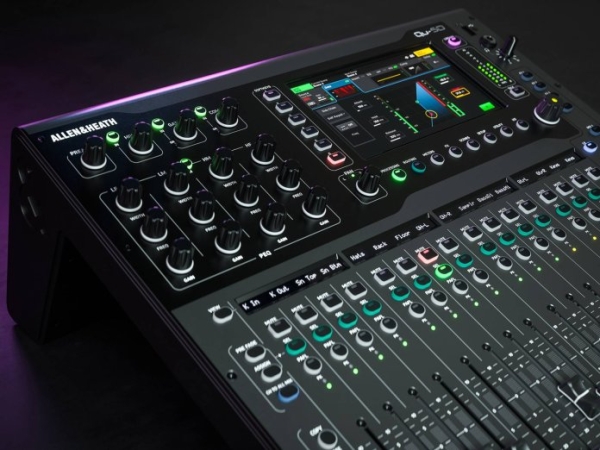Allen & Heath Unveils New Generation of Qu Mixers Featuring Dante Support: “Every Aspect of the Mixer Has Been Re-thought”
By [Your Name] | Published: [Insert Date]
In a landmark move that promises to reshape the compact digital mixer landscape, Allen & Heath has unveiled its next generation of Qu Series digital mixers, this time packing in one of the most requested features by audio professionals—native Dante support. With a resounding statement that “every aspect of the mixer has been re-thought,” the British audio technology pioneer signals not just an update, but a complete reimagination of its best-selling digital mixer line.
This announcement is sending ripples through the pro audio industry, exciting everyone from church sound engineers to live performers, broadcast professionals, and studio producers. So, what’s behind this next-gen release, and why is it such a big deal?
Let’s dive deep into the new Allen & Heath Qu series and unpack the innovations, implications, and industry impact of this significant leap forward.
A Legacy of Excellence
Before we examine what’s new, it’s important to understand the legacy of the Qu Series. Originally launched in 2013, the Qu line quickly became a fan-favorite for its intuitive interface, robust build quality, and studio-grade audio performance—all within a compact, rack-mountable form factor.
Whether it was the Qu-16, Qu-24, or Qu-32, users appreciated the consistent workflow, seamless USB recording, iPad app control (Qu-Pad), and integration with Allen & Heath’s ME personal monitoring systems. These mixers became a staple in houses of worship, educational institutions, mobile DJ setups, and smaller-scale live production companies.
However, as the digital landscape evolved, a few gaps began to show—most notably, the absence of native Dante support. Audio professionals had to rely on third-party options or cumbersome expansions to connect with Dante networks. The new generation of Qu mixers solves this, and much more.
The Dante Difference
Let’s start with the headline feature: Dante support.
For the uninitiated, Dante (Digital Audio Network Through Ethernet) is the de facto standard for low-latency, high-quality digital audio networking. Developed by Audinate, it allows audio signals to travel over standard Ethernet networks with zero degradation and near-zero latency.
With native Dante support built directly into the new Qu mixers, the advantages are significant:
1. Simplified Connectivity
No more requiring an optional card or external Dante interface. Now, the new Qu mixers can connect directly to Dante-enabled devices—such as wireless mic systems, amplifiers, stage boxes, and even computers—over a single Cat5e or Cat6 cable.
2. Scalability
Whether you're building a small system or integrating into a massive Dante network, the new Qu mixers can slot right in. You can route up to 64 channels of audio with ease, enabling complex setups previously out of reach for compact consoles.
3. Multi-Track Recording Made Easy
With Dante Virtual Soundcard, multi-track recording to a DAW becomes as simple as selecting the Qu mixer as an input source. Engineers can now run full virtual soundchecks, remix performances post-show, or broadcast live audio directly from the mixer via Ethernet.
4. Broadcast-Ready
For corporate AV, live streaming, and broadcast scenarios, Dante opens the door to pristine digital audio routing over existing networks. The mixer can now feed isolated tracks or sub-mixes to streaming PCs, recorders, and broadcast trucks—all digitally.
Re-Thinking the Workflow: Hardware & Software Enhancements
Allen & Heath didn’t stop at Dante. They truly re-thought the entire Qu ecosystem from the ground up. Here are the standout enhancements:
1. Upgraded Touchscreen & UI
The new Qu mixers feature a higher-resolution touchscreen with faster response times and improved menu layouts. Navigation is more intuitive, with gesture-based controls and better visual feedback on EQ curves, routing, and metering.
The software has also been rebuilt with a modern architecture, ensuring stability and responsiveness, even in demanding live environments.
2. Revamped Preamp Design
While the previous Qu series had transparent, professional preamps, Allen & Heath has gone a step further by introducing digitally controlled, studio-grade preamps that deliver even cleaner gain structure and reduced self-noise. The company claims the new preamps are inspired by their high-end dLive consoles.
Expect better dynamic range, headroom, and clarity—especially crucial for vocal performances, acoustic instruments, and classical ensembles.
3. Enhanced FX Engine
The next-gen Qu boasts a more powerful DSP engine, allowing for expanded internal FX processing. Users now get new reverb algorithms, multiband compression, dynamic EQ, and improved delay effects with greater parameter control.
Allen & Heath has even hinted at future FX plugin expansions, potentially downloadable via firmware updates.
4. Flexible I/O Options
In addition to Dante, the mixers now come with more AES digital outs, assignable stereo/mono outputs, and a revised USB-C interface that supports 32x32 multitrack recording at 96kHz.
This means you can record an entire concert in pristine quality to your laptop, or stream high-resolution audio over USB to platforms like OBS, Zoom, or DAWs such as Ableton Live and Logic Pro.
5. iOS & Android App Control
The all-new Qu Control app is redesigned for both iOS and Android platforms. It allows remote control of faders, scenes, FX, routing, and monitor mixes—ideal for sound engineers walking a venue during soundcheck or musicians managing their in-ear mixes.
Latency has been reduced, and the new app also supports custom layouts—perfect for giving non-technical users access to only the controls they need.
A Future-Proof Platform
Allen & Heath is not just selling a mixer—they’re building a platform. With modularity in mind, the next-gen Qu series is designed for firmware expandability, network integration, and future-proof protocols.
Firmware and Features in Development:
-
AoIP Bridging: Upcoming firmware may allow bridging between Dante and other AoIP protocols (AES67, Ravenna).
-
Cloud Scene Backup: Save and recall mixer scenes and user profiles from the cloud.
-
Wireless Dante Control: Remote Dante patching via tablet or laptop.
-
MIDI Over Dante: Control lighting or other gear via MIDI routed through Dante.
These updates show Allen & Heath's commitment to long-term value and innovation—a trait not all mixer brands share.
Applications: Who Stands to Benefit?
The new generation of Qu mixers isn’t just a niche upgrade. Here’s who will find it transformative:
1. Live Sound Engineers
The ability to route audio digitally with Dante and control from anywhere means faster setup, cleaner signal paths, and tighter control over performances—without lugging around analog snakes.
2. Houses of Worship
Churches and mosques can now build Dante-based ecosystems with confidence. The flexibility to connect to recording setups, wireless microphones, and distributed speaker systems simplifies otherwise complex installations.
3. Broadcast & Streaming
A direct-to-stream or broadcast setup becomes plug-and-play. With Dante and high-resolution USB audio, operators can send separate mixes to FOH, monitors, livestreams, and recorders effortlessly.
4. Education
Music and production schools get a platform that teaches both traditional mixing skills and modern audio networking—bridging the gap between analog roots and digital futures.
5. Touring Bands & DJs
Compact enough for the road, yet powerful enough for full shows, the new Qu mixers allow artists to maintain consistent mixes and integrate with backline or front-of-house systems globally—especially as Dante becomes ubiquitous.
Competitive Landscape: How Does It Stack Up?
The digital mixer space is more competitive than ever. Brands like Behringer (X32), Yamaha (TF Series), and PreSonus (StudioLive) all offer powerful options with varied features.
However, Allen & Heath’s blend of:
-
Solid build quality
-
Exceptional UI design
-
Pristine preamps
-
True Dante integration
-
Long-term firmware vision
…makes the new Qu lineup a clear contender for leadership in the mid-range digital mixer category.
For those already embedded in the Dante ecosystem or considering futureproof investments, Allen & Heath just made your decision easier.
Price & Availability
While final pricing may vary by region, Allen & Heath has confirmed the new Qu mixers will start shipping in Q3 2025, with prices expected to be:
-
Qu-16 Dante: $2,199 USD
-
Qu-24 Dante: $2,799 USD
-
Qu-32 Dante: $3,599 USD
These price points are competitive, especially considering the integrated Dante functionality which used to add $500–$1,000 to previous models via expansion cards.
Retailers and integrators are already taking pre-orders, and Allen & Heath has hinted at a bundle program with ME personal mixers and stage boxes to promote ecosystem adoption.
Final Thoughts: A Mixer for the Modern Age
With the new generation of Qu Series digital mixers, Allen & Heath has proven it’s not just keeping up—it’s leading. By blending decades of analog expertise with forward-thinking digital design, the company has created a tool that’s not just about mixing—it’s about empowering creativity across workflows.
The native Dante support is the star of the show, but the total reimagining of the mixer’s interface, preamps, FX engine, and control options make it clear this is more than a minor upgrade.
For professionals and semi-pros alike, the new Qu is an invitation to step into the future of sound—with flexibility, quality, and confidence.
What do you think of the new Allen & Heath Qu mixers? Will Dante support change how you work? Let us know in the comments below.
For more in-depth tech breakdowns, product news, and gear reviews, subscribe to our newsletter or follow us on socials.
Let me know if you want this formatted for a specific website, platform (like Medium or WordPress), or adapted into a shorter press release or newsletter.


